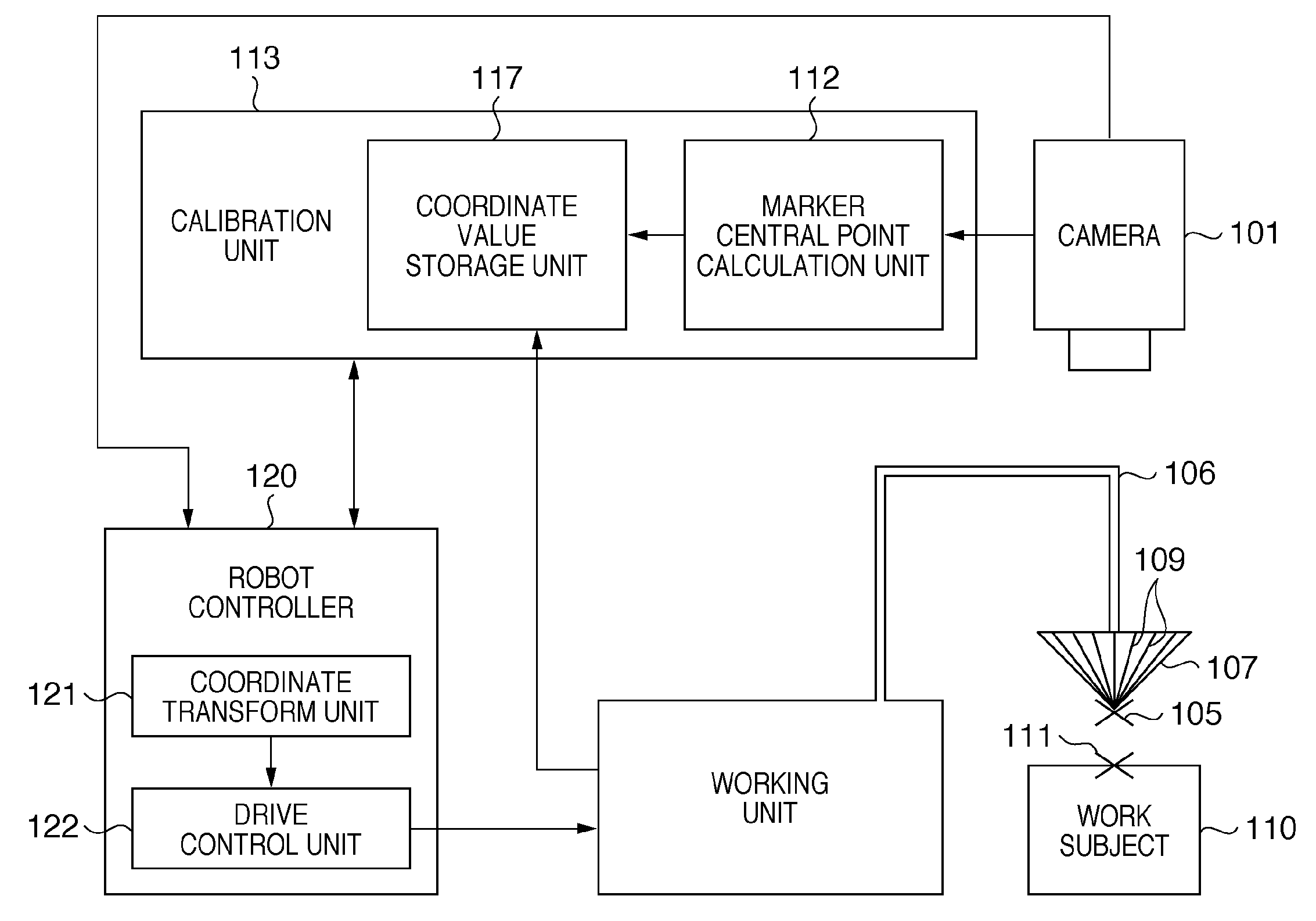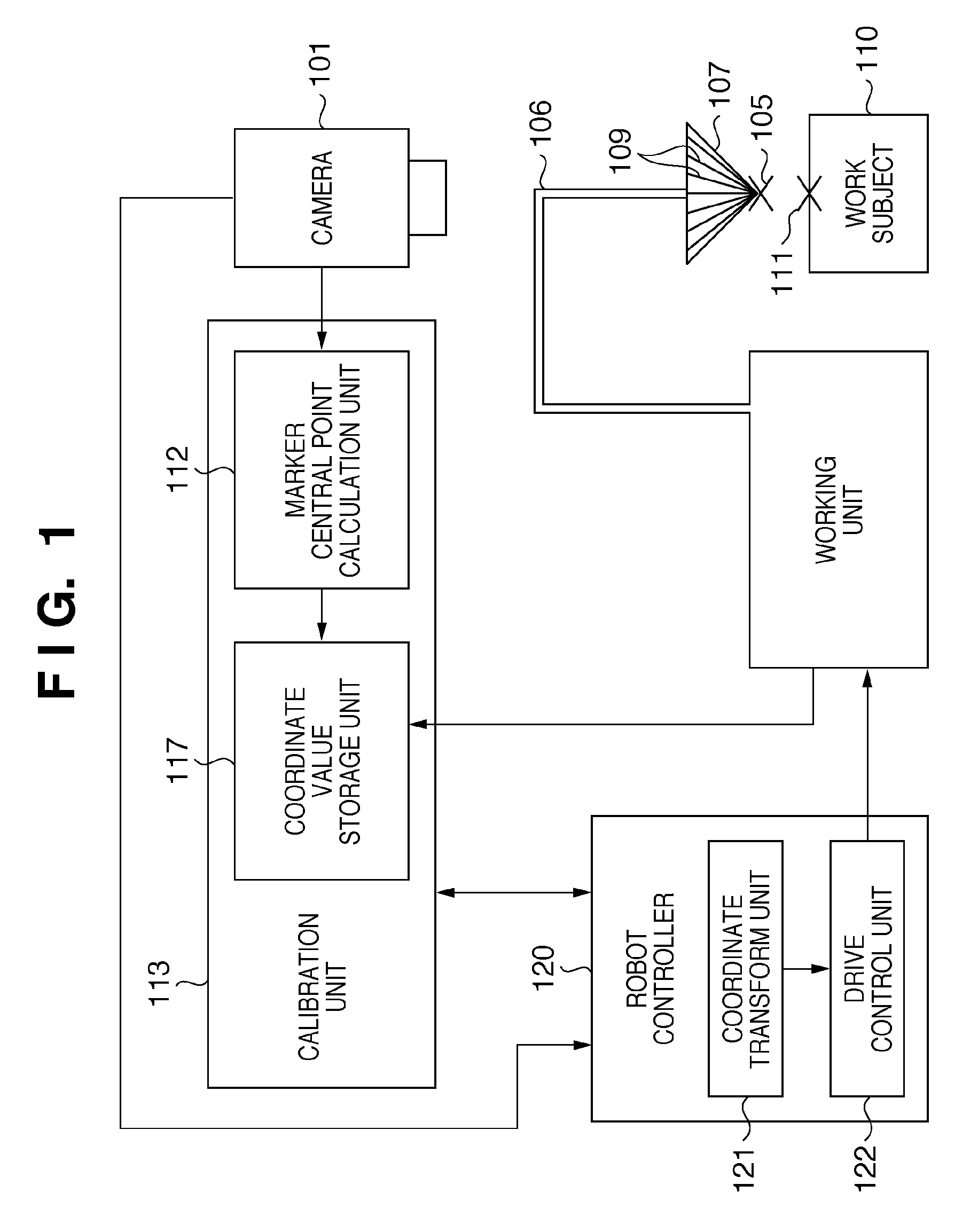Working apparatus and calibration method thereof
a technology of working apparatus and calibration method, which is applied in the direction of electrical programme control, program control, instruments, etc., can solve the problems of limiting the freedom of movement of the robot arm, large portion of the indicator surface and large blockage of the calibration jig pla
- Summary
- Abstract
- Description
- Claims
- Application Information
AI Technical Summary
Benefits of technology
Problems solved by technology
Method used
Image
Examples
first embodiment
[0028]In the first embodiment, a method of calibrating a position in three-dimensional space to increase the precision of work before a robot arm which is a working unit operates on a work which is a work subject will be given. In the present embodiment, image coordinates which are coordinates directly on an image and robot coordinates which are coordinates on an apparatus are calibrated without deriving camera parameters in advance.
[0029]FIG. 1 is a block diagram illustrating a machine control apparatus and a robot as a controlled machine according to the first embodiment. Further, FIG. 2 is a perspective view illustrating a robot according to the first embodiment.
[0030]A robot controller 120 comprises a coordinate transform unit 121 and a drive control unit 122. A coordinate transform unit 121 transforms coordinates on an image captured by a camera 101 into robot coordinates which are coordinates on an apparatus. A drive control unit 122 controls the entire robot including a worki...
second embodiment
[0064]Next, as a second embodiment, a calibration method that does not use a laser distance meter 108 will be described. In this method, calibration of multiple degrees of freedom (DOF) robot arms other than XYZ orthogonal robot arms such as scalar or multiple perpendicular-joint robot arms is possible. In the second embodiment, a robot arm, the same calibration jig as that used in the first embodiment, and two or more cameras are used. By using a three-dimensional form for the markers, the markers can be stably observed from any angle, and a calibration reference point can be simultaneously observed from various angles. In the second embodiment, calibration reference points are observed by a plurality of cameras using these marker characteristics. Moreover, the composition of the second embodiment is mostly the same as that of the first embodiment (FIG. 1), and has a form in which a plurality of cameras 101 is connected.
[0065]Regarding the plurality of cameras 101, each camera para...
third embodiment
[0072]Next, as a third embodiment, and as derivative methods of the calibration processing explained in the second embodiment, methods which do not utilize calibration jigs such as those shown in FIGS. 3A through 3H or FIGS. 9A through 9C during calibration work will be given. In the present embodiment, first, 4 markers are distributed at predetermined positions on the robot arm. Next, in the same manner as in the second embodiment, a calibration jig is fixed and measured with a camera, and a calibration reference point and 4 markers are detected. These are transformed to world coordinates, and the positions in world coordinates of the reference point and 4 markers are acquired. Next, the relative positional relationships in world coordinates of the 4 markers and calibration reference point are stored. Next, the calibration jig is removed, and thereafter the position of the calibration reference point in world coordinates is determined from the relative positional relationships of t...
PUM
 Login to View More
Login to View More Abstract
Description
Claims
Application Information
 Login to View More
Login to View More - R&D
- Intellectual Property
- Life Sciences
- Materials
- Tech Scout
- Unparalleled Data Quality
- Higher Quality Content
- 60% Fewer Hallucinations
Browse by: Latest US Patents, China's latest patents, Technical Efficacy Thesaurus, Application Domain, Technology Topic, Popular Technical Reports.
© 2025 PatSnap. All rights reserved.Legal|Privacy policy|Modern Slavery Act Transparency Statement|Sitemap|About US| Contact US: help@patsnap.com



